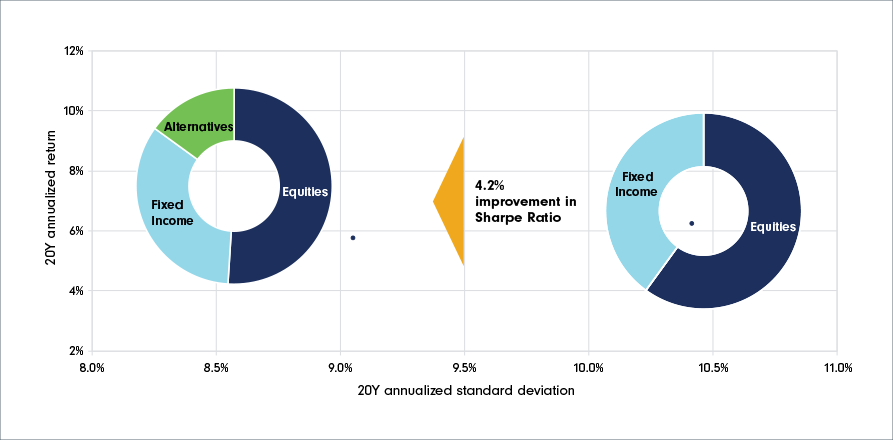Source: Fidelity Investments Canada ULC, as of December 31, 2022. HFRI Equity Market Neutral Index, MSCI World Net Index and Bloomberg Barclays Global Aggregate Index in their respective base currencies. The performance shown above is used solely to illustrate the historical performance of the HFRI Equity Market Neutral Index and does not reflect the actual performance of any particular fund. Hedge fund indices are based on voluntary self-reported returns that may lead to a positive bias. Market indices are not adjusted for any investment fees. It is not possible to invest directly in an index. Index performance is not meant to represent that of any Fidelity Fund. Past performance is no guarantee of future results. Sharpe ratio calculated based on the 3-month U.S. Treasury Bill return in base currency as the risk-free rate of return. The Sharpe ratio is a measure of risk-adjusted returns and is calculated as the ratio between a portfolio’s excess return over a risk-free rate and its standard deviation.
The HRFI Equity Market Neutral Index is a global, equal-weighted index in U.S. dollars. Returns included are net of all fees. Excludes funds of hedge funds. If a fund in an index liquidates or closes, that fund’s performance will be included in the HRFI up to the fund’s last reported performance update. Tracks head funds that typically maintain characteristic net equity market exposure no greater than 10% long or short.
This Fund is an alternative mutual fund. It has the ability to invest in asset classes or use investment strategies that are not permitted for conventional mutual funds. The specific strategies that differentiate this Fund from conventional mutual funds may include: increased use of derivatives for hedging and non-hedging purposes, increased ability to sell securities short and the ability to borrow cash to use for investment purposes. If undertaken, these strategies will be used in accordance with the Fund’s investment objectives and strategies, and during certain market conditions, may accelerate the pace at which the Fund decreases in value.
The Fidelity Market Neutral Alternative Fund has obtained exemptive relief to permit it to engage in short-selling strategies in excess of the short-selling limits permitted under applicable securities legislation for both alternative mutual funds and conventional mutual funds. Consistent with the Fund's investment objectives, the Fidelity Market Neutral Alternative Fund may engage in the short-selling of securities and/or cash borrowing with a combined limit of 100% of its net asset value.
The statements contained herein are based on information believed to be reliable and are provided for information purposes only. Where such information is based in whole or in part on information provided by third parties, we cannot guarantee that it is accurate, complete or current at all times. It does not provide investment, tax or legal advice, and is not an offer or solicitation to buy. Graphs and charts are used for illustrative purposes only and do not reflect future values or returns on investment of any fund or portfolio. Particular investment strategies should be evaluated according to an investor's investment objectives and tolerance for risk. Fidelity Investments Canada ULC and its affiliates and related entities are not liable for any errors or omissions in the information or for any loss or damage suffered.



